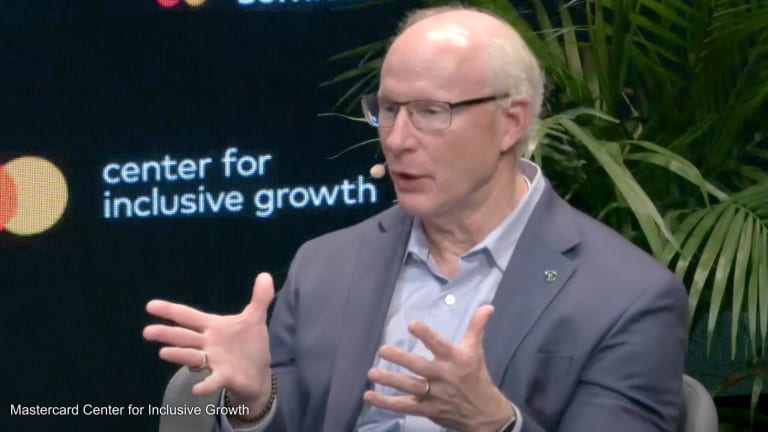
Robert Annibale is a leading figure in the world of microcredit. As Citigroup’s top microfinance expert, he represents the global bank at gatherings around the world.
Annibale joined Citibank in 1982 and since then has held a number of senior treasury, risk and corporate positions around the globe. In 2005, he was named global director of Citi Microfinance division, which focuses on developing commercial relationships with microfinance institutions, networks and investors around the globe. This department is active in more than 40 countries and works with more than 100 microfinance institutions worldwide.
Born and raised in New York, Annibale earned a degree in history and political science from Vassar College as well as a master’s in African history from the University of London’s School of Oriental and African Studies. In addition to his financial expertise, Annibale also has experience in academic and governmental circles, serving on the U.K. Foreign and Commonwealth Office’s Africa Policy Group, and the boards of the University of London, Institute of Commonwealth Studies and St. Anthony’s College Center for the Study of African Economies at Oxford University.
In September 2009, Annibale spoke at the Encuentro Centroamericano de Microfinanzas in San Salvador, El Salvador. Devex caught up with Annibale at the conference, and he discussed Citibank’s role in the microfinance world, the impact of the recession on microfinance globally, and trends in Citibank’s collaboration with local microfinance institutions.
How does Citi Microfinance work with microfinance institutions around the world?
Citi Microfinance works with microfinance institutions, going beyond philanthropy, as clients and partners for our businesses. It is about, how do we design products or help microfinance institutions access capital in their local markets and in their local currency? The one different thing about Citi no matter whether it’s in Latin America or Asia or anywhere, being in over 100 countries, we always think in local terms. It may be a global approach, but everything we do is in local language, local currency, in local law, and the relating is through our local presence.
A big part of this conference is discussing how Central American microfinance institutions are dealing with the recession. What have you seen worldwide with microfinance institutions that you work with?
Microfinance institutions were affected. They were not completely decoupled or uncorrelated as people might have thought in the past. That’s because they’ve grown: They have more funding and investment coming from around the world that integrates them more in what happens globally.
But most [institutions] have been very much driven by local events. So we see huge differences in how it’s been impacted. If I look at India, or Bangladesh, or Indonesia - the biggest markets where institutions have millions of clients or members - we have seen the least impact from the global recession. Everywhere, one thing is common, and that is that everybody started to slow the pace of growth, but that’s from a really high level. We had institutions in India that were doubling every year in growth. In Latin America, they were growing by 40 percent or 50 percent per year. That’s fine when you have 8,000 clients; it’s very different when you have a million clients. When you start to get to the point where you have a million clients, it’s very hard to sustain that with quality, with training, with recruitment, with operations and processing.
Globally, what we saw is the microfinance sector responded pretty quickly to seeing what was happening. It was quite removed in months or a year in impact [on the microfinance sector]. And they started to slow the pace of growth.
Markets where you had more international funding being formed like Eastern Europe or Latin America, you would generally say that liquidity got tighter and the costs of funds increased. People that were beginning to access capital markets began to delay that.
In this region, like others as well, I do think there’s another dynamic while the global markets may bring institutional challenges. What’s impacting their clients is perhaps even more profound and some of that’s the global increase in the price of food, the increase in the price of energy. People are paying a lot more for their basic foods, paying a lot more for energy. They’ve also found that their remittances have been reduced quite significantly; that is a very important part, if we think of household income; so the stress on household income with all those elements will take an effect on their cash flow and their ability to service debt.
Another factor that has nothing to do with the global markets is where you get an excessive growth in the client sector, and you get this issue of over-indebtedness. The lack of the tools of a credit bureau that would have helped institutions recognize that people were borrowing from too many institutions too much. We saw that happen in the 1990s in Bolivia, when there was very dramatic extension of credit that couldn’t be sustained. In the past year or so, an example would have been Morocco, which has had phenomenal growth, enormous need, good institutions. But we found in the end that clients were borrowing from too many at the same time, and it wasn’t resulting in increased cash flow for the client quickly enough for the client to service their debt. And you saw an increase in the arrears.
Central America is probably feeling more the implications more than in other parts of the world [because] remittances are a much bigger part of the income. The markets are smaller. In some cases, the important component of foreign funding is key. They are also mostly institutions that can’t take deposits. Deposit-taking institutions are faring much better. That’s a big stabilizer for an institution.
What regions or countries do you see as the growing microfinance markets currently, and what are the requirements for you to decide to work with an institution?
Brazil is one of those countries with a very strong banking system and a very comprehensive system. Every municipality in the country has an access to at least one bank. It really is an interesting place that has learned to survive hyperinflation and came out with strong banks, and has a very extensive consumer finance tradition.
In Mexico, we have some of the biggest microfinance institutions in Latin America: Compartamos. You have groups that are emerging. Mexico is a very vibrant place. Obviously, [in] markets like Mexico and India, we have a bigger footprint.
[In order to work with an institution,] it also has to be an institution that is at the right moment for them. They have to be at the right level to take on debt. They need to be commercially sustainable. It needs to be appropriate in financing terms that they can really service commercial financing. We look for institutions that have the institutionalization and the capacity to grow, and where we can play a role in that and we have to assess what that role would be.
How do you initially identify and contact these organizations around the world in order to work with them?
We try to focus on our [Citibank] colleagues, the countries themselves. What are the leading institutions that we have a relationship with or could develop one locally? We also leverage the international networks, groups like Accion, Grameen Bank, Women’s World Bank. We know all those groups.
People do come to us too that are [part of] really interesting institutions. We rely a lot on local knowledge in the countries, because the great thing there is that they really understand the contextual sense of how an institution fits in that domestic market form a regularity perspective, from a governance perspective. If I look at the board of an institution, I will probably not recognize anyone on the board unless they have international members; [Citibank’s local representatives] may recognize most of them.








